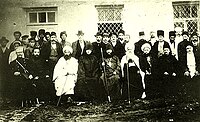Armenian–Azerbaijani war (1918–1920)
| Armenian-Azeri war 1918 | |||||||
|---|---|---|---|---|---|---|---|
| |||||||
| Belligerents | |||||||
| Democratic Republic of Armenia | Azerbaijan Democratic Republic | ||||||
| Commanders and leaders | |||||||
| Andranik | Samedbey Mehmandarov | ||||||
With the declarion of Armenia and Azerbaijan after the Russian Revolution of 1917 ended with a series of brutal and hard to classify wars between 1918, than 1920 to 1922. The conflict did not have a main pattern with standard armed structure. The conflicts involved civilians in the disputed districts of Kazakh-Shamshadin, Naxcivan, Zanghezur and Karabakh. The use of guerrilla and semi-guerrilla operations were the main reasons for the high civillian casulties, which matches to nation building activities of newly established states. The reasons of behind the conflict is still far from being resolved after nearly a century.
The story of this campaign has very different perceptions; according to Armenian historians, Democratic Republic of Armenia was to include among the basic (Eastern Armenia) territoories of Yerevan province including Naxcivan and Ordubad districts, as well as the eastern and southern parts of Elisavetpol (Ganca) province.
Background
First clashes between the Armenians and Azeris took place in Baku in February 1905. Soon, the conflict spilled over to other parts of the Caucasus, and on August 5, [1905]] first conflict between the Armenian and Azeri population of Shusha took place. As a result of mutual pogroms and killings, hundreds of people died, more than 200 houses were burned just only in the Shusha.
Fight for Baku
In March 1918, ethnic and religious tension grew and the Armenian-Azeri conflict in Baku began. Musavat and Committee of Union and Progress parties were accused of "Pan-Turkism" by Bolsheviks and their allies. Armenian and Muslim militia engaged in armed confrontation, with the formally neutral Bolsheviks tacitly supporting the Armenian side. According to Azeri sources, thousands of Muslims were killed by extremist Armenian Dashnaks. Muslims were expelled from Baku, or went underground.
At the same time the Baku Commune was involved in heavy fighting with the advancing Caucasian Ottoman Army in and around Ganja. Major battles occurred in Yevlakh and Agdash, where the Turks routed and defeated Dashnak and Russian forces.
The things reversed back one more time when Enver Pasha, Ottoman Empire, begin to move forward with the newly established Army of Islam. Dunsterville ordered the evacuation of the city on September 14, after six weeks of occupation, and withdrew to Iran; most of the Armenian population escaped with British forces. The the Army of Islam and their Azeri allies, led by Nuri Pasha, entered in Baku on September 15. The capital of the Azerbaijan was finally moved from Ganja to Baku. However, after the armistice of Mudros between Great Britain and Ottoman Empire on October 30, Turkish troops were substituted by the Triple Entente. Headed by British general W. Thomson, who had declared himself the military governor of Baku, 5,000 Commonwealth soldiers arrived in Baku on November 17, 1918. By General Thomson's order, martial law was implemented in Baku.

The Armenian government tried several times to seize Shusha militarily. In January 1919 Armenian troops advanced towards Shusha, captured and destroyed 9 Azeri villages on their way but eventually had to retreat. Just before the Armistice of Mudros was signed, Andranik was on the way from Zangezur to Shushi, to control the main city of the Karabakh. The Armenian government tried several times to seize Shusha militarily, before. In January 1919 Armenian troops advancing, the British forces ordered Andranik back to Zangezur, and gave him the assurances that this conflict can be solved with the Paris Peace Conference, 1919. Andranik pulled back his units and British command at Baku gave the control to the Dr. Khosrov Bek Sultanov. Khosrov bey Sultanov, a native of Karabakh was appointed the general-governor of Karabakh. He had three Armenian and three Azeri aides.
Fight for Karabakh, 1920
The largest Armenian-Azeri ethnic clashes in Shusha took place on March-April 1920. On the night from March 21-22, 1920 when the Azeris celebrated Spring Equinox (Novruz Bayram), local Armenian groupings organized a surprise attack aimed at cleansing the town from the Azeri population.
They seized the approaches to Shusha, Khankendi, and the Askeran fortress and began to attack the Azeri part of the town and burn the houses on their way. In parallel, regular Armenian army units attacked Zangezur, to the west of Karabakh.
However, the effect of suddenness backfired at the Armenians. Azeris infuriated by the attack on their holy day, launched a counteroffensive to the Armenian quarters of Shusha and burned almost the whole Armenian part of the town, forcing the Armenian population to flee. During these clashes thousands of people from both Armenian and Azeris died, more than 7,000 houses were burned and Shusha was virtually cleansed of its Armenian population.
The fighting increased in intensity by February 1920 and martial law was introduced in Karabakh, which was enforced by the newly formed National Army, led by general Samedbey Mehmandarov.
